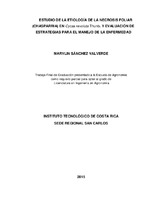Mostrar el registro sencillo del ítem
Estudio de la etiología de la necrosis foliar (Chasparria) en Cycas revoluta Thunb y evaluación de estrategias para el manejo de la enfermedad
| dc.contributor.author | Sánchez-Valverde, Marylin | |
| dc.date.accessioned | 2016-06-13T19:48:13Z | |
| dc.date.available | 2016-06-13T19:48:13Z | |
| dc.date.issued | 2015 | |
| dc.identifier.uri | https://hdl.handle.net/2238/6473 | |
| dc.description | Proyecto de Graduación (Licenciatura en Ingeniería en Agronomía) Instituto Tecnológico de Costa Rica, Escuela de Ingeniería en Agronomía, 2015 | es |
| dc.description.abstract | The following investigation was conducted with the objective of developing strategies to manage the foliar necrosis of cycas with plan knowledge and the study of the etiology of the disease. The investigation was divided in three stages. In the first stage the various phases of leaf development were determined. These were designated as: Infant (V1), Formation (V2), Juvenile (V3) and Mature (V4). Furthermore a photographic scale represented 12 phases of these foliar development was designed. In the second stage, it was determined that the causal agent of chasparria was Colletotrichum proteae. The fungus was isolated from diseased tissues and inoculations to healthy plants were made. The disease symptoms were reproduced and the same fungus was isolated from infected tissues of all inoculated plants. Furthermore, the symptoms caused by C. proteae under experimental conditions were similar to those observed for chasparria in commercial farms. The disease presented an incubation period (IP) of three to five days on phases V1, V2, V3 and a latent period (LP) of six days; for phase V4 the IP was seven days and LP nine days. The leaves that were affected with more severity were those of phases V2 and V3. In another experiment the sensitivity in vitro of C. proteae to fungicides (protectant and systemic) was tested. Six concentrations of the active ingredient (0.01, 0, 0.1,1, 10, 100 ppm) of each fungicide were tested. The active ingredient were categorized as high sensitivity <1 mgL-1 (prochloraz, difenoconazole y propineb), medium sensitivity 1 - 10 mgL-1 ( pyrimethanil), low sensitivity 10 - 50 mgL-1 (metiram) and insensitivity y >50 mgL-1 (clorotalonil, azoxistrobin, boscalid, mancozeb and mancozeb + oxicloruro de Cobre. Protectant fungicides, metiram, propineb and clorotalonil resulted in a highly percent of inhibition of the mycelial development. Prochloraz, difenoconazole and pyrimethanil were the best of the systemic fungicides tested. During the field trials, two experiments with experimental designs that consisted of five blocks and four treatments were conducted. One of them consisted in the evaluation of the rotation of conventional (T1) and non-conventional fungicides (T4) and the addition of acetic acid (50 ml L-1) (T2-T3). It was determined that the conventional treatment is the best to manage chasparria in field conditions. The acetic acid decreased the severity of the disease in the T2 and T3 but increase it in T1 treatment. In the other field experiment of phase three foliar fertilization using (Ca, Mg and Si as a management strategy for chasparria was tested). Results of this experiment indicate that the treatments did not have an effect in the severity of the symptoms of chasparria. To evaluate the severity of the symptoms in the two field experiments, a scale of 0-7 (0=no symptoms and 7=severe symptoms) was developed and validated at the beginning of the experiments. Simultaneously with this study, an informative manual for the management and culture of cycas was developed. | es |
| dc.language.iso | spa | es |
| dc.publisher | Instituto Tecnológico de Costa Rica | es |
| dc.rights | acceso abierto | es |
| dc.rights.uri | https://creativecommons.org/licenses/by-nc-nd/3.0/cr/ | * |
| dc.subject | Colletotrichum proteae | es |
| dc.subject | Enfermedades de las plantas | es |
| dc.subject | Manejo del cultivo | es |
| dc.title | Estudio de la etiología de la necrosis foliar (Chasparria) en Cycas revoluta Thunb y evaluación de estrategias para el manejo de la enfermedad | es |
| dc.type | proyecto fin de carrera | es |



